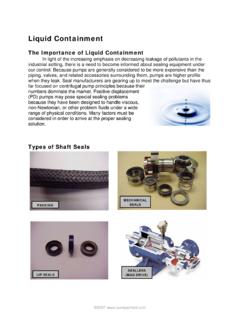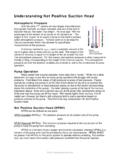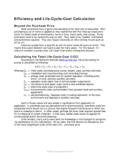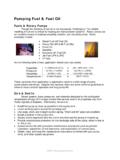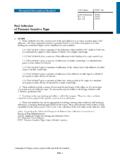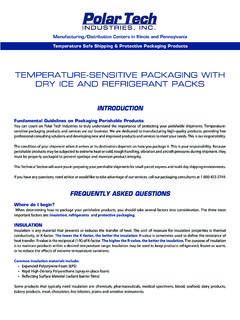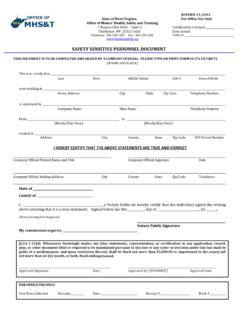Transcription of Handling Shear Sensitive Liquids
1 Handling Shear Sensitive Liquids Newtonian and Non-Newtonian Liquids Newtonian Liquids are those that hold their viscosity regardless of Shear rate. Consider stirring a glass of water; no matter how fast you stir, the water retains its viscosity. Conversely, non-Newtonian Liquids change in viscosity depending on the Shear rate (figure 1). Paint for example is Shear thinning, decreasing in viscosity as it is stirred. A corn starch and water mixture (sometimes referred to as oobleck) is Shear thickening, literally allowing someone to run across the liquid s surface, but sink in slowwly if they remain stationary. Figure 1 Viscosity versus Shear Rate for Non-Newtonian Liquids Shear sensative Liquids are non-Newtonian Liquids , often requireing specal coniderations for Handling .
2 Some examples of Shear sensative Liquids are: Paints and pigments Polymers Latex Solutions Mayonaise Coatings Slurries Ketchup Creams / Shampoo What is Shear ? Shear seems like a simple enough concept to most people until they re asked to define it. Related to Liquids , Shear is defined as relative motion between adjacent layers of a moving liquid . Some of the simplest examples include spreading butter on bread or applying sunscreen. In each case one level of the liquid (butter on the knife) is moving relative to the adjacent layer (butter on the bread). By also considering the velocity of this relative motion, we can calculate the Shear rate.
3 Shear rate is defined as the measure of the extent or rate of relative motion between adjacent layers of a moving liquid . Therefore: Shear Rate = Velocity / Distance Using the same example, we can raise the Shear rate by either raising the velocity of the knife or by placing the knife closer to the bread. By further breaking down the equation: Shear Rate = (Distance / Time) / Distance = Time-1 Using seconds as the unit of time, Time-1 becomes seconds-1. Shear rate is normally expressed in units of reciprocal seconds (sec-1). 2007 Shear Rate as it Pertains to Pump Selection As discussed above, Shear Sensitive Liquids can behave very differently when sheared.
4 Some require Shear to get them to the ideal viscosity for transfer or application. Others can be temporary or irrevocably damaged by Shear . It s important to discuss the liquid s nature with the manufacturer or to have a rheology test performed to determine how the liquid behaves when sheared over time. As soon as the liquid leaves the vessel and enters the suction piping, it begins to Shear as the liquid traveling through the middle of the pipe moves in relation to the pipe walls. The pump imparts Shear as well between the rotating pumping elements and the stationary casing. Calculating these Shear rates is possible using the equation above and considering the flow rate, pipe diameters, pump rotational speed, and internal pump dimensions.
5 Combined with the liquid s rheology data, this can help to make an educated decision regarding pump selection and sizing. Which Pump is the Lowest Shearing? This is a commonly asked question by pump users and the answers vary from expert to expert. Calculations, while giving a good frame of reference, don t help to answer this question either. Progressive cavity pumps, widely regarded as being a low Shear pump, have internal contact between the pumping element and the casing; to run a Shear rate calculation delivers a rate of infinite sec-1. First off, very little of the liquid is actually being sheared. Most is carried through in large cavities between the lobes or gear teeth.
6 Only a small percentage along the OD of the pumping elements is experiencing this maximum Shear rate. Secondly, speed is key, which rules out traditional centrifugal pumps. It s not uncommon to see rotary PD pumps turning at speeds below 100 RPM for extremely Shear Sensitive Liquids like latex solutions. Lobe pumps, Internal Gear pumps, and Progressive Cavity pumps are just some of the rotary PD pumps that are commonly applied to Shear Sensitive Liquids . Experience will often dictate pump selection more than anything. Water treatment plants often use lobe pumps or progressive cavity pumps to dose the Shear Sensitive polymers. The polymer manufacturers often use internal gear pumps for the same liquid .
7 One paper mill uses lobe pumps for their paper coatings, another uses internal gear pumps, each is convinced that the other doesn t know what they re doing. The short answer is that they re both right. Running positive displacement pumps at low speeds and utilizing application knowledge from the pump representative and liquid manufacturer is the surest way to select a pump for Handling Shear Sensitive applications. 2007
